
HPU2. Nat. Sci. Tech. Vol 02, issue 01 (2023), 16-24
HPU2 Journal of Sciences:
Natural Sciences and Technology
journal homepage: https://sj.hpu2.edu.vn
Article type: Research article
Received date: 02-02-2023 ; Revised date: 23-3-2023 ; Accepted date: 05-4-2023
This is licensed under the CC BY-NC-ND 4.0
An improvement of newton – krylov method for solution of
nonlinear equations
Van-Trung Lai
a
, Mai-Lien Quach Thi
a,*
a
University of Information and Communication Technology, Thai Nguyen University, Thai Nguyen, Vietnam
Abstract
Solving problems in practice often results in a system of nonlinear equations with a large number of
equations and unknowns. Finding the exact solution to this class of equations is very difficult and
almost impossible. Recently, with the development of technology, many methods and algorithms have
been proposed to approximate the class of these systems of equations. Especially the third-order
Newton–Krylov method has solved quite well this class of systems of equations with the third degree
of convergence. In this paper, we present a new improvement of the third-order Newton-Krylov
method with a quaternary convergence rate and prove the convergence of the iterative formula. In
addition, the paper also presents an experimental result to demonstrate the convergence speed of the
method.
Keywords: Iterative formula, Convergence, Convergence speed, Nonlinear equations system, Third-
order Newton-Krylov method.
1. Introduction
Consider a system of nonlinear equations
0F x
, (1)
where
1 2
t
n
F f x , f x ;...; f x
with
n
i
f :
are nonlinear functions. ( 1 2i , ,...,n).
* Corresponding author, E-mail: qtmlien@ictu.edu.vn
https://doi.org/10.56764/hpu2.jos.2023.1.2.16-24

HPU2. Nat. Sci. Tech. 2023, 2(1), 16-24
https://sj.hpu2.edu.vn 17
Many scientists have researched and proposed methods to solve the system of equations (1) with
quadratic convergence, such as Newton's method [1], Chebyshev's method, Halley's method [2] and
other methods. The third-order convergent iterative method is presented in [4]-[9]. However, these
methods have high computational complexity when the number of equations and unknowns of the
system is large.
In 2011, Frontini and Sormani proposed an improved Newton method with a third order
convergence rate [8], [9] as follows:
Newton – Krylov method
Consider the system of equations
1n n n n n n
F x s F x , s x x ,n
. (2)
The Newton-Krylov method finds an approximate solution of (2) with condition
n n n n n
F x s F x F x
,
with
0 1
n
,
is called constraint condition.
Newton-Krylov aglorithm:
1. Set
0
x
;
0 1
max
,
.
2. Give
0 1
n , ,...,
and:
• Chose 0
n max
; ,
• Apply an iterative method to find
n
s
of
n n n
F x s F x .
The process will stop if the following condition is satisfied
n n n n n
F x s F x F x
.
• Correct
1
n n n
x x s
.
Third-order Newton-Krylov method.
We consider
1
1
1
2
n
n n
n n n
F x
x x
F x F x F x
. (3)
To obtain The Newton-Krylov algorithm, we rewrite fomula (3) as follows
1
1
1
2
n n n n n n
F x F x F x x x F x
(4)
Set
1
1
2
n n n
k x F x F x
.
Then we can write
1
2
n n n
F x k x F x
(5)
So we can apply the Krylov method to find the approximate solution
n
k x
of equation (5).
Fomula (4) is rewritten as follows

HPU2. Nat. Sci. Tech. 2023, 2(1), 16-24
https://sj.hpu2.edu.vn 18
n n n n
F x k x s F x ,
(6)
with
1
n n n
x s x .
(7)
We continue applying the Newton-Krylov algorithm to find
1
n
x
of system (6), (7).
The convergence and convergence speed of the Third-order Newton-Krylov method are
presented in [12], [13].
In this paper, we present a new improvement of the third order Newton-Krylov method with
quaternary convergence speed and prove the convergence of the iterative formula. The structure of the
paper consists of four parts as follows: The first part of the paper is Introduction. In the next section,
we present the algorithm to improve the third order Newton-Krylov algorithm with quaternary
convergence speed and proves the convergence. of the iterative formula. The third section presents the
experimental results and Section 4 is the Conclusion.
2. Improved algorithm
We consider the iterative fomulation
1
1
1 2 1
,
6 3 2 6
n n
n n n n n
x g x
x x F x F F g x F x
(8)
where
1*
1n n n n n
g x x F x F x F x
và
1
*
.
n n n n
x x F x F x
Then the fomulation (8) is rewritten by the following three iteration formulas
*
n n n n
F x s F x
với
* *
n n n
x x s
,
* *
1n n n n n
F x g F x F x
với
*
,
n n n
g x x g
( )
1 2 1
( ) ( )
6 3 2 6
n n
n n n n
x g x
F x F F g x s F x
với 1
.
n n n
x x s
We use the Newton-Krylov algorithm to solve the three above systems of equation finding the
solutions
* *
,
n n
s g
và
n
s
.
Next, we prove the convergence of this algorithm.
Theorem 2. 1 ( The convergency of improved iterative fomula) Let :
n n
F
is continuous
differentiable function on a convex open set
n
D
. Assume there exists *
n
x
and
, 0
which
satisfies
* * * 1
, , 0, ( )
S x r D F x F x
exists,
1
*
,
F x
and
*
, .
F Lip S x r
There exists
0
so that with each 0 *
,
2
x S x
dãy 1 2
, ,..., ,...
n
x x x determined by formula (8) which converges to
*
x
.
To prove Theorem 2.1, we first present the following propositions
Lema 2.2 (Xem[14]) Let
n
E,I
, where
I
is the unit matrix. If
1
E
then
1
I E
exists

HPU2. Nat. Sci. Tech. 2023, 2(1), 16-24
https://sj.hpu2.edu.vn 19
and
11
1
I E .
E
Morever,if
A
is a invertible matrix and
1
1
A B A
then
B
is also a
invertible matrix and
1
1
1
1
A
B .
A B A
Lema 2.3 (See[14]) Let the function
n m
F :
be a continuously differentiable map on an
open convex set
D
and
F Lip D
, then for every
x p D
we have
2
2
F x p F x F x p p .
Then, we will provide proof for Theorm 2.1. Given
1
min , 2
r
.
With 0 *
,
2
x x F
Lípchitz at
*
x
, according to Lema 2.3, we have
1 1
* 0 * * 0 * 0 *
1
.
2 4
F x F x F x F x F x F x x x
Acoording to proposition 2.2 we have invertible
0
F x
and
1
*
1 1
0 *
1
* 0 *
4 4
.
3 3
1
F x
F x F x
F x F x F x
From the definition
*
1
n
x
, we have
1 1
* * 0 * 0 0 0 * 0 0 * 0
1
.
x x x x F x F x F x F x F x F x x x
Therefore
2
12
* * 0 * 0 0 * 0 0 *
1
4 2
.
3 2 3 4 2
x x F x F x F x F x x x x x
Therefore we have * *
1
, .
2
x S x
From the definition
n
g x
, ta có
1
0 0 0 0 *
1
g x x F x F x F x
,therefore
1 1
0 * 0 * 0 0 * * * 0 *
1 1 1
1
0 * 0 0 * 0 * 0 0 * 0
1
.
g x x x x F x F x F x x x F x F x
F x F x F x F x x x F x F x F x x x
Applying Lema 2.3 we have
1 1
0 * 0 * 0 0 * 0 0 * 0 0 * 0
1
2 2 2 2
* 0 0 * * * * * 0 * 0 *
1 1 1
2
4 2 2
3 2 3
85 .
216 2
g x x F x F x F x F x x x F x F x F x F x x x
x x x x x x x x x x x x

HPU2. Nat. Sci. Tech. 2023, 2(1), 16-24
https://sj.hpu2.edu.vn 20
Therefore we have
0 *
, .
2
g x S x
‘
Then we have
0 0 1
* 0 * 0 0 * 0 *
1
1 1
2 2 2
x g x
x x x F x F x F x x x
, therefore
0 0 1
* 0 * 0 0 * 0 *
1
0 * 0 *
1 1
2 2 2
1 1 .
2 2 4 4 2
x g x
x x x F x F x F x x x
g x x x x
Thus we conclude that
0 0
*
, .
2 2
x g x
S x
Given
1 2 1
6 3 2 6
x g x
H x F x F F g x
, then
1
1
n n n n
x x H x F x
.
From definition
H x
we have
0 0
0 * 0 * * 0 *
1 2 1
6 3 2 6
x g x
H x F x F x F x F F x F g x F x
From 0 *
,
2
x x F
Lípchitz at
*
x
, so according to Lema 2.3 we have
1
* 0 *
0 0
1
* 0 * * 0 *
1 2 1
.6 3 2 6
F x H x F x
x g x
F x F x F x F F x F g x F x
0 0
0 * * 0 *
2 1
6 3 2 6 12 3 12 4
x g x
x x x g x x
.
We have
1
*
1 1
0 *
1
* 0 *
4 4
.
3 3
1
F x
H x F x
F x H x F x
On the other hand, we then have
1
0 0
1 0
x x H x F x
It follows that
1 1
* 0 * 0 0 0 * 0 0 * 0
1
x x x x H x F x H x F x F x F x x x
.
Or


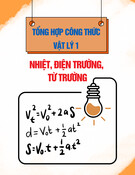
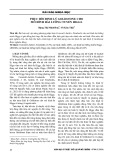
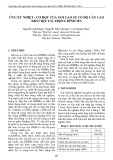
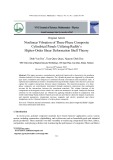
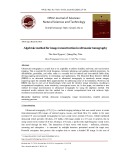
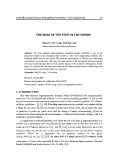
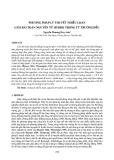

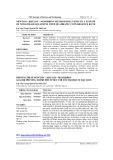
![Bài giảng Vật lý đại cương Chương 4 Học viện Kỹ thuật mật mã [Chuẩn SEO]](https://cdn.tailieu.vn/images/document/thumbnail/2025/20250925/kimphuong1001/135x160/46461758790667.jpg)














